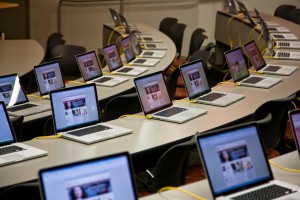Can tools of distraction become tools of learning?
 As the number of wireless computing devices increase while getting smarter, smaller, and less expensive, more students are using them in the classroom. When computers, tablets or smart phones are used by students in the classroom, do they add value or distract from learning?
As the number of wireless computing devices increase while getting smarter, smaller, and less expensive, more students are using them in the classroom. When computers, tablets or smart phones are used by students in the classroom, do they add value or distract from learning?
A University of Michigan research study, Use of Laptops in the Classroom: Research and Best Practices (PDF) (Zhu et al, 2011), suggests that while the opportunity for distraction exists, over half (53%) of students in the study self-reported that they learned more when using a laptop in class with intentionally computer-based course assignments. The key is integrating use of the laptop into class activities. “… Many students appear to weigh the options of using or not using laptops during class and make decisions based on what may be most helpful for their own learning.”
The U-M study, confirmed that laptops are like any classroom tools –“they function best when they fulfill a clear instructional goal and when they are used in specific ways that support student learning.”
The report concludes that when used for specific pedagogical purposes, computing devices can provide benefits for student learning, but also present potential for distraction. “Given that the number of students who own laptops and other mobile devices is increasing steadily, faculty will need to think carefully about their approach to student laptop use and how they can maximize the benefits while minimizing the distraction.”
The research group offered policies and logistical suggestions for faculty to consider:
- Include a clearly worded laptop policy in your syllabus. (See samples of laptop policies.) Not having a policy implies that you allow laptops in class.
- Consider suggesting that non-laptop users seat themselves in classroom locations that minimize visibility of laptop screens to help reduce distraction.
- If you permit students to use laptops in the classroom, check to see if the room has sufficient power outlets and flexibility so that students can move around to work in groups and design activities that enable students without laptops to participate in problem-solving or team assignments.
- Assign activities or tasks to complete in class, such as reflection, problem-solving, very short writing assignments, project design, blog posts, or similar activities that must be performed and completed before the end of class. This “studio time” enables faculty to provide assistance to individuals or groups as they apply concepts learned earlier in the course.
A similar research study at the University of Ontario (PDF) looked at benefits and challenges of using laptops in classrooms using a survey of 177 undergraduate students (Kay and Lauricella, 2011). Nearly 75% indicated that laptops were useful in supporting their academic experience. Similar to conclusions from the U-M study, the Ontario research supports the observation that “meaningful laptop activities is a critical determinant of benefits and challenges experienced in higher education classrooms” (Kay and Lauricella, 2011). The study indicated both benefits and challenges of using computing devices in class:
- Benefits: note-taking activities, in-class laptop-based academic tasks, collaboration, increased focus, improved organization and efficiency, and addressing special needs.
- Challenges: other student’s distracting laptop behaviors, instant messaging, surfing the web, playing games, watching movies, and decreased focus.
Teaching and Learning Technologies stands ready to partner with you to explore ways to apply iPads, laptops, or cellphones in your class. We also have other engagement tools, such as clicker systems and various types of tablets you can check out. In addition, academic technology consultants can assist you in exploring how free applications such as Google Moderator or Live Question Tool can enhance your students’ learning. Learn more by contacting Teaching and Learning Technologies at tlt@elon.edu or 278-5006.
Zhu, E., Kaplan, M., Dershimer, R. C., and Bergom, I. (2011). Use of laptops in the classroom: research and best practices, CRLT Occasional Papers 30. Center for Research on Learning and Teaching, University of Michigan at Ann Arbor.
Kay, R. H. and Lauricella, S. (2011). Exploring the benefits and challenges of using laptop computers in higher education classrooms: a formative analysis, Canadian Journal of Learning and Technology, 37/1. University of Ontario Institute of Technology.
Photo by Flickr user Standford EdTech / Creative Commons licensed BY-NC-ND 2.0
 About the author
About the author
Ben McFadyen is an academic technology consultant at Elon University who actively translates between teaching, learning, and technology. He works with faculty to explore how technology can be used to enhance student learning and provide efficient, effective ways to achieve pedagogical goals.
 Follow
Follow
